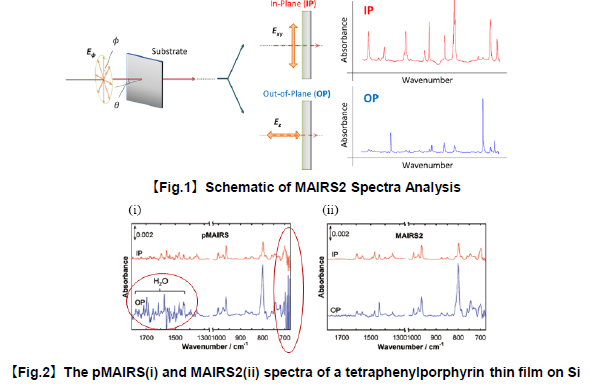Available Technologies
High-Precision Molecular Orientation Analysis for Organic Thin Films
Enables high-precision measurement and analysis of molecular orientation of amorphous materials such as organic semiconductors and biomembranes
Background
p-Polarized Multiple-Angle Incidence Resolution Spectrometry (pMAIRS) is a spectroscopic technique that enables functional-group-level analysis of molecular orientation in thin films, even in amorphous materials. It plays a crucial role in elucidating interfacial chemical reaction mechanisms and in the development of functional materials. By combining Fourier-Transform Infrared Spectroscopy (FT-IR) with the pMAIRS method, it has become possible to simultaneously obtain both in-plane (IP) and out-of-plane (OP) spectra— traditionally acquired separately via transmission and reflection-absorption methods—on a unified vertical scale. This advancement enables quantitative analysis of molecular orientation in thin films [JP4340814]. However, conventional IR spectroscopic methods including pMAIRS have faced issues such as the inability to eliminate optical fringes (interference patterns) and water vapor peaks (noise) arising from samples or substrates. Additionally, changes in the incident angle cause variations in the irradiated area, which introduces instability in measurements.
Description and Advantages
To overcome these issues, the inventors developed an improved method called MAIRS2 [JP 6861351][Fig. 1], which analyzes IP and OP spectra by varying the polarization angle (φ) of linearly polarized light, instead of changing the incidence angle (θ). This new approach significantly reduces interference from water vapor and allows even small absorption peaks to be clearly detected. It also enables the removal of optical fringes originating from the sample or substrate [Fig.2].
⮚ Key Strengths of pMAIRS and the Enhanced MAIRS2 Method
• Enables simultaneous acquisition of two types of spectra--equivalent to transmission
and reflection-absorption methods--from a single sample
• Allows quantitative analysis of molecular orientation in thin films at the level of
individual functional groups by combining with FT-IR
• Capable of analyzing molecular orientation in amorphous regions that are difficult to
measure using X-ray diffraction (XRD)
• Enables analysis of molecular orientation in low-smoothness thin films where
polarization analysis methods such as ellipsometry are ineffective
⮚ Fundamental Solution to the Common Challenges of Conventional Thin-Film IR Spectroscopy, Including pMAIRS [Fig.2]
• Avoids the issue of residual water vapor peaks characteristic of FT-IR
• Eliminates optical fringe (interference pattern) issues

| Development Status |
•Inventor’s prior invention[JP4340814] and current invention [JP6861351]licensed to spectroscopic instrument manufacturers by respective licensors; currently available as commercial products. •Licensing available to multiple sectors. |
|---|---|
| Intellectual Property |
|
| Offer | •Non-exclusive licensing agreements •Option agreements •Joint research collaborations |
| Related Links | View PDFView in Japanese |
Have you found what you were looking for?
- Interested in a particular research activity
- Cannot find the information
- Have questions on how to utilize research results
Feel free to contact us and get answers to your questions.
Inquiry- TLO-KYOTO
- Available Technologies
- High-Precision Molecular Orientation Analysis for Organic Thin Films
3rd Floor, International Science
Innovation Building, Kyoto University
Yoshidahonmachi, Sakyo-ku, Kyoto
606-8501 JAPAN


